Hydrangea - care in the fall and preparation for winter
Different types and varieties of hydrangea tolerate winter cold in different ways. In addition, they can grow in different climatic zones, so there are nuances in caring for them in the fall in preparation for the upcoming cold weather.
Below you will find information about autumn care and preparation of the plant for winter, about pruning hydrangeas in the fall and sheltering it for the winter, which will be useful for both beginners and already experienced gardeners who have recently planted this perennial in their summer cottage.

Content
How to care for hydrangeas in autumn: secrets of care and preparation for cold weather
The composition of the hydrangea care activities in the fall includes the following:
- Eradicating autumn spraying (treatment) from diseases and pests (as an option, you can use a 3% solution of Bordeaux liquid).
- Transfer (but only paniculate or tree-like varieties, it is better to transplant large-leaved varieties in spring).
By the way! You can plant new hydrangea seedlings in autumn.
- Reproduction (by dividing a bush or digging in layers, but cuttings are carried out only in summer).
By the way! You can transplant a shrub just by propagating it by dividing the bush.
- Top dressing and watering (more on this later).
- Pruning.
- Shelter for the winter.
Moreover especially important properly prepare the hydrangea for winter, namely, to hold autumn pruning and shelter for the winter.
Autumn feeding of hydrangea and its watering regime
When the hydrangeas finish their flowering, and their buds begin to dry out gradually, it's time for autumn feeding, which should help the shrub to hibernate in a strong state, successfully laying vegetative and flower buds for future growth and flowering in the new year.
In the fall, potash-phosphorus fertilizers must be applied to the soil, hydrangeas are no exception. During this period, it will be good to feed them with potassium sulfate - as a potassium fertilizer, superphosphate - as a phosphorus fertilizer. Or you can buy ready-made autumn fertilizer.
Remember! No nitrogen fertilizers in the autumn, and no ash as a potassium supplement, because it alkalizes the soil, while hydrangeas, on the contrary, need soil-acidifying fertilizing.
But watering in the fall is practically stopped (especially if the weather is cloudy and / or rainy), although, as you know, hydrangea loves moisture very much, so it is very important to water it regularly during hot periods of the year during abundant flowering.
Features of autumn pruning hydrangea
Many lovers of this wonderful flower often have questions about this procedure: when is it better to cut it - in autumn or spring; and is it necessary to prune the hydrangea at all for the winter? It is worth dealing with these issues in more detail. In addition, if this procedure is carried out incorrectly, then the shrubs can bloom poorly and, in principle, leave the gardener without their beautiful flowers throughout the season.
By the way! About others reasons why hydrangea may not bloom, You can find out from this detailed material.
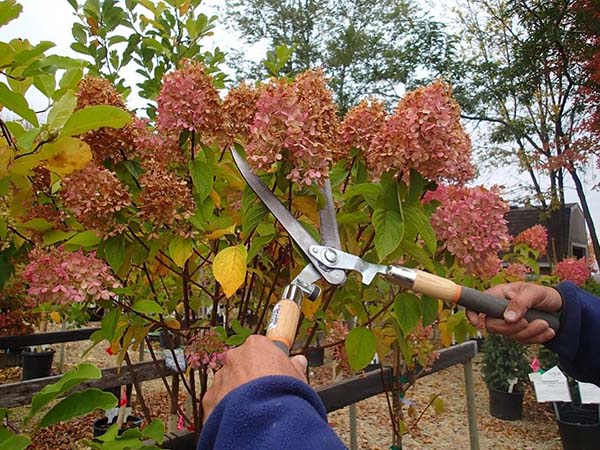
Note! Details about pruning hydrangeas in the fall you can read in this detailed article.
Do I need to cut for the winter
In the fall, it is imperative to remove all faded (dry) inflorescences, otherwise in winter hydrangea bushes can simply break under the weight of snow. And also does not interfere with sanitary and thinning pruning.

When is the best time to prune - in autumn or spring
It is believed that paniculate and tree-like hydrangeas can be pruned both in autumn and in spring, or pruned in several stages (some should be cut off in the fall and finished in spring). But the large-leaved variety, as a rule, is tried to be cut only in the spring. Pruning of young bushes 2-3 years old (which still have thin stems) is most often also left in the spring.
Important! More on pruning hydrangeas in spring read here, about autumn - here.
Features of autumn pruning of a plant, depending on the species
Let's consider separately how the tree-like, paniculate and large-leaved varieties are pruned, since each of them has its own characteristics.
Note! Detailed information about pruning paniculate, tree-like and large-leaved hydrangeas in autumn You can find outfrom this detailed article.
Pruning paniculate variety
As a rule, in autumn at panicle hydrangea cut off only faded inflorescences, and already in the spring they carry out a complete (final) pruning, that is, pruning is carried out in 2 stages.
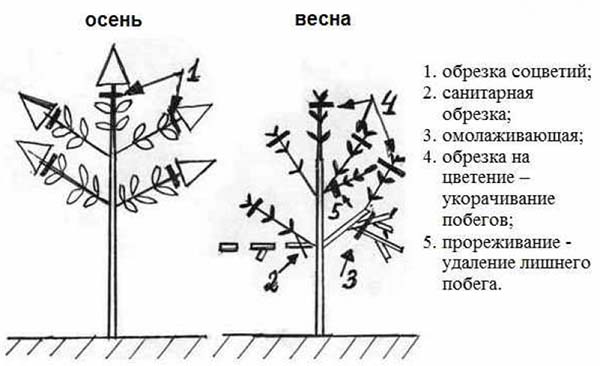
However, the flowering of paniculate, like a tree-like hydrangea occurs on the shoots of the current year, which means that it is not at all scary to make a mistake when pruning. thereforein the fall, you can carry out a complete pruning of the tree hydrangeabut leaving some margin.For example, when pruning for flowering, 3-4 pairs of strong buds should be left.
Pruning a tree species
Note! Autumn pruning of tree hydrangea performed similar to paniculate, but with some nuances (due to the structure of the flower). Naturally, you can do full pruning in the fall because it also blooms on the shoots of the current year.
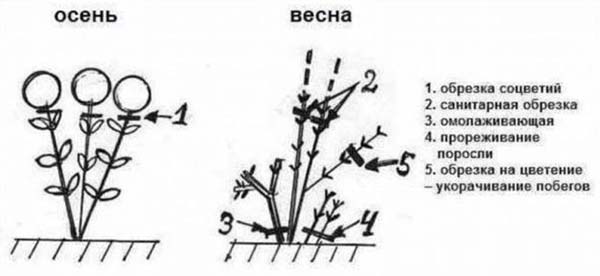
Pruning a large-leaved variety
The large-leaved hydrangea blooms on last year's shoots, so it requires a completely different pruning. And if you do standard pruning, you can simply deprive yourself of flowering next year.
So, in the fall, in the large-leaved variety, only faded two-year-old shoots are cut off, all other pruning procedures are transferred to spring.
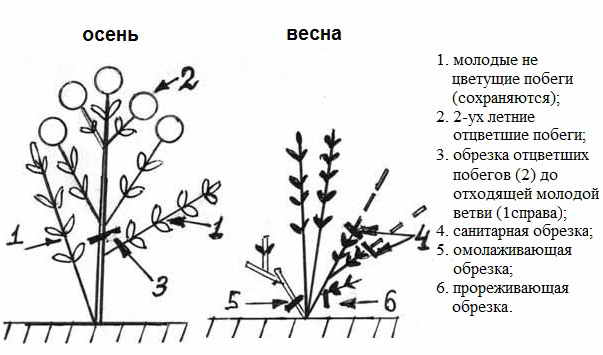
Note! Many growers prefer not to touch the large-leaved hydrangea at all in the fall, but to do everything in the spring.
But you can still cut the inflorescences in the fall. Moreover, it is recommended to cut the inflorescences to the first pair of buds at the end of the twig, that is, they (buds) should never be touched. In addition, a stem of about 1.5-2 cm (long stump) should be left above them.
Shelter hydrangea for the winter
Many novice flower growers are interested in the shelter of this perennial for the winter, namely: when and how to do it correctly.
Note! The site already has a detailed article about the shelter of hydrangeas for the winterwhich you can find by this link.
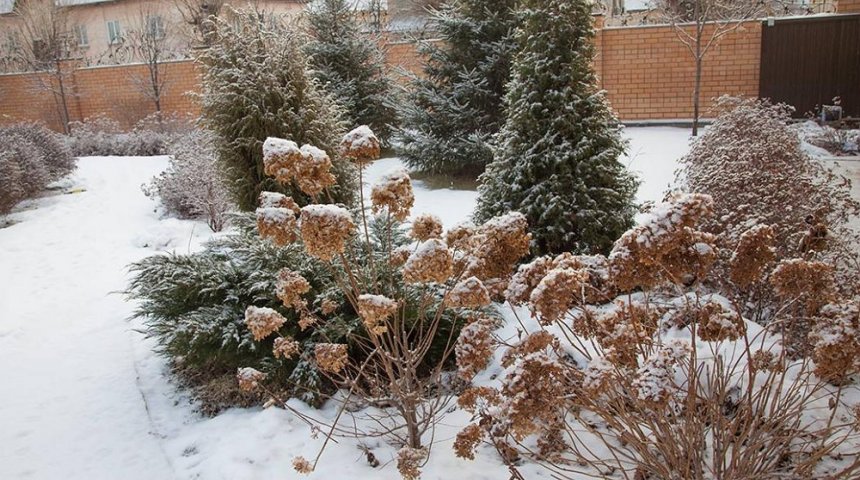
Features of frost resistance of each type of hydrangea
Panicle hydrangea is one of the most frost-resistant species, it can withstand frosts down to -30-35 C.
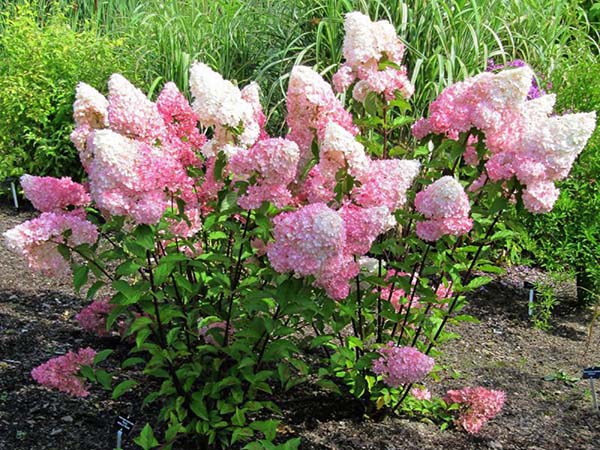
Slightly less frost-resistant is a tree-like variety, in which young shoots can freeze during the cold season. But the plant usually recovers very quickly during the next season.
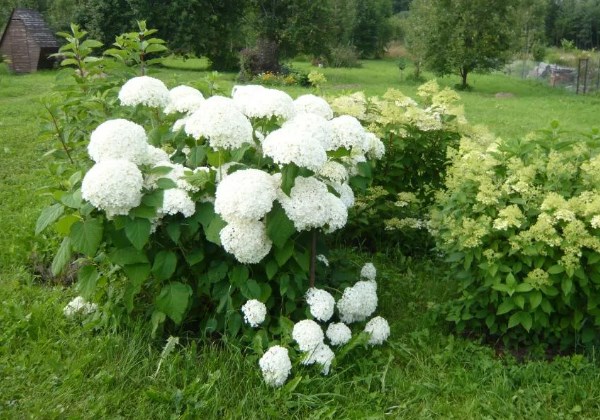
And the most unstable to cold weather is the large-leaved hydrangea. The fact is that this perennial blooms on the shoots of the previous year. And if flower buds freeze during the winter, then next year there will be no flowering.
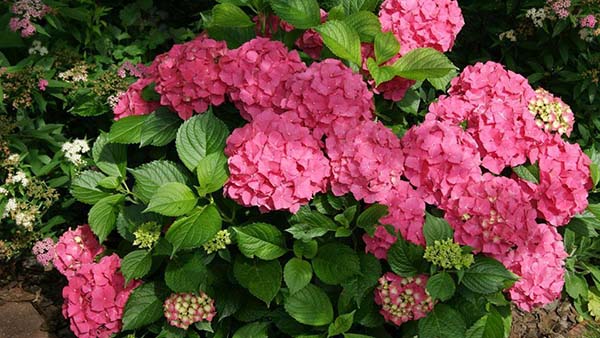
Is it necessary to cover for the winter
Thus, not all varieties of hydrangea need to be sheltered for the period of cold weather, or rather only tree and paniculate, since they are highly frost-resistant. It will be enough just to slightly huddle each of the bushes (for insurance).
But the large-leaved hydrangea is strongly recommended to be carefully covered for the winter, since it is a very thermophilic species. Therefore, if this shrub is not covered in the Middle Lane (Moscow region) and the cold northern regions, then it will definitely not bloom.

Features of the shelter of hydrangeas, depending on the region
In the Urals and Siberia, experienced flower growers manage to grow large-leaved hydrangea, many varieties of which are valued for the beautiful decorative appearance of the foliage, as well as for the beautiful flowers of different colors. To cover well for the winter this thermophilic variety in the northern regions, it should be planted separately from other plants so that its shelter does not interfere with the development and growth of other flowering perennials.Some gardeners sometimes even grow this type of plant in large tubs, which are harvested in a greenhouse for the winter. or to the greenhouse.
As for how to cover large-leaved hydrangeas in the middle lane (Moscow region), an air-dry shelter is used here (although it can be used both in Siberia and the Urals), for example, such a plan:
- The perennial shoots are tied together, wrapped with lutrasil, and a mesh frame is built around, the size of which is 10-12 cm greater than the height of the bush. Dry foliage is poured inside the frame to the very top. Then the resulting structure must be wrapped with any material that does not allow moisture to pass through. In this way, young seedlings of all types of hydrangeas should be covered for the winter.
Attention! The site already has a detailed article about the shelter of hydrangeas for the winterwhich you can readby this link.

These wonderful shrubsactively grown in landscape design for decorating park areas. But more and more often they are found in the most common summer cottages and in the gardens of private houses. However, flower growers need to remember that these perennials require special treatment in preparation for the cold season.

